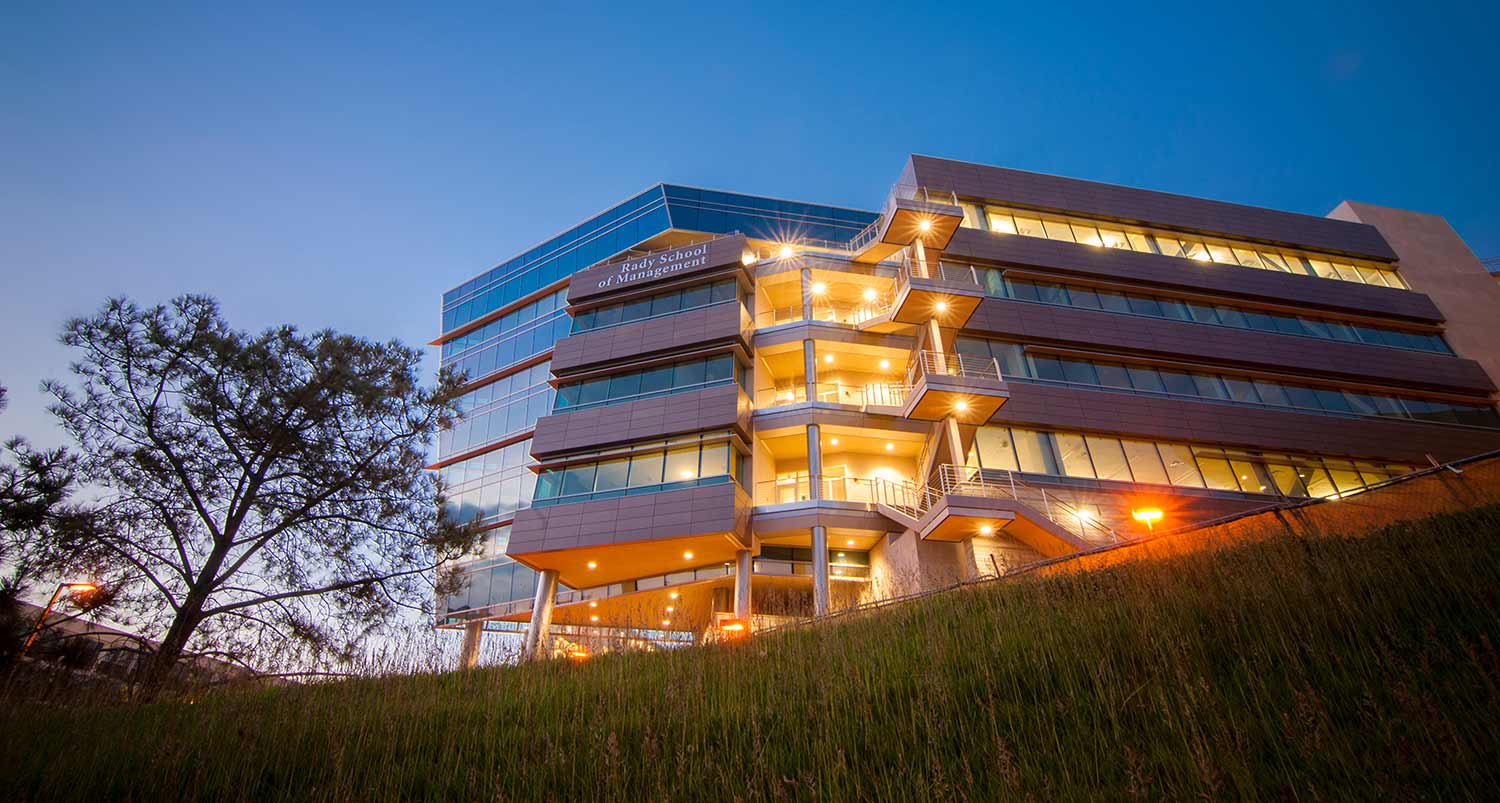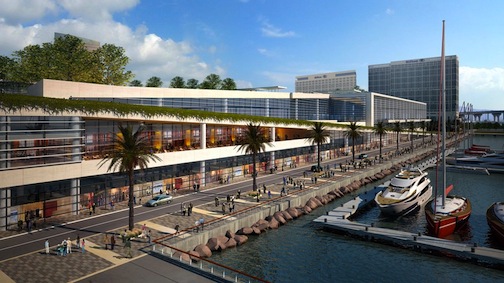Daily Business Report-April 18, 2016
The almost finished new Downtown Central Courthouse in San Diego. (click here for full image)
San Diego’s New Central Courthouse
Downtown Ready to be Topped Off
Rudolph and Sletten Inc. will celebrate the topping out of the New San Diego Central Courthouse in Downtown San Diego on Wednesday at 11 a.m.
The topping out will recognize the work of the construction crews and project partners as the 25-story, $555 million project is assembled to its full height.
When occupied in early 2017, the new courthouse, located at 1100 Union St., will combine several of The Superior Court of San Diego County’s spaces and offer a full-service facility for criminal, civil, probate, family, and small claims matters, with space for court administration, security operations, and holding areas.
Among the speakers at the topping out event will be Martin Sisemore, president & CEO, Rudolph and Sletten, and Superior Court Judge Kenneth So.
The event will also include a ceremony as the final beam of the building, signed by all 650 construction crew members, is placed atop the high-rise. The development, designed by Skidmore, Owings & Merrill LLP, is intended to meet the U.S. Green Building Council’s LEED Silver standards.
Courthouse Facts:
$555 million development
25 stories; 704,000 square feet
71 courtrooms and 104 holding cells.
22 total elevators: two for courthouse staff, 16 for the public, three for the detainees, and 1 service elevator.
6 sets of escalators, each moving at a rate of 100 feet per minute.
Building will offer full-service, consolidated facility for criminal, civil, probate, family, and small claims courts, with space for court services, administration, security operations, and holding areas.
Project will replace and consolidate the County Courthouse, the Family Courthouse, and the Madge Bradley Courthouse in Downtown San Diego.
The Design
Designed by Skidmore, Owings & Merrill LLP
New 180-foot long pedestrian bridge will cross over the trolley, and connect the existing Hall of Justice’s fourth floor to the new courthouse’s third floor.
Building is embellished with a precast concrete, 10-foot tall sculpture of The Great Seal of the State of California.
Cantilevered trusses at the top of the structure extend 65 feet from the face of the building. Within the overhang will be 72 diamond-shaped metal panels at 9 feet by 35 feet, and weighing 1,200 pounds each.
650 construction workers at peak construction.
3.5 million pounds of rebar and 16,329 cubic yards of concrete poured into the foundation alone.
Approximately 15,000 tons or 30 million pounds of structural steel.
160,000 square feet of exterior glass.
____________________________________________
Newsweek: ‘How Jerry Brown Quietly Saved California’

San Diego Makes Medtech Innovation Ranks
San Diego is emerging as an innovator in the field of wireless medical technology, after having secured a spot as a general wireless tech leader after Qualcomm was founded there in 1985.
San Diego comes in fifth on Qmed’s recent list of top cities for Medtech innovation. The ranking relied on audience feedback as well as data on NIH funding, venture capital investing and more
Innovators such as Sotera Wireless, which makes the innovative ViSi Mobile wireless monitor, are based there. Qualcomm and the West Wireless Foundation are all based in the area and are helping to foster innovation in the digital health sector. The city pulls in substantially less funding than the the Bay Area, but still is one of the top metros in the U.S. for medical technology VC funding.
The area is also a biotech leader and is home to research organizations like the Scripps Research Institute.
No. of Medical Device Employees: 7614
Medtech VC Investing (2013): $48M
Annual operating cost with facility construction: $10.4M
NIH Funding (FY 2014, Congressional Districts 50, 52-53): $521M
___________________________________________________
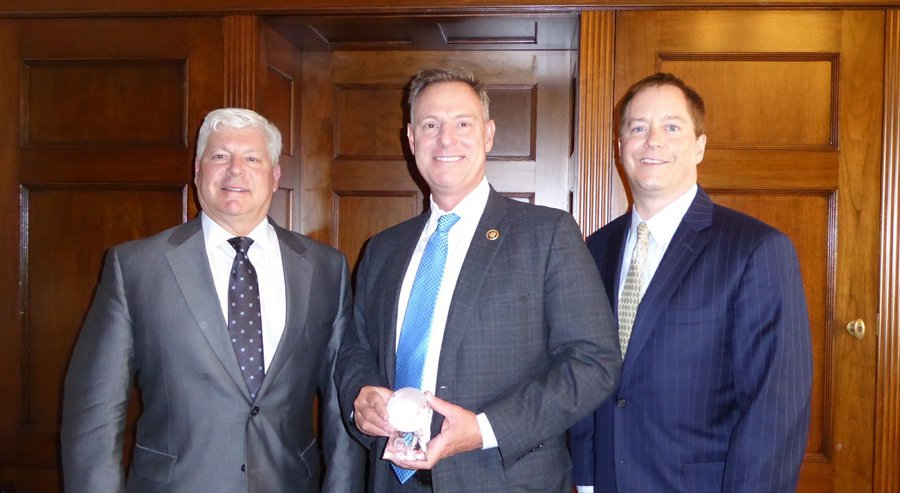
Congressman Scott Peters (center) receives the 2016 BIO Legislator of the Year Award. With him are Joe Panetta (left), president and CEO of Biocom, and Todd Gillenwater, executive vice president of CLSA. (Courtesy of BIO)
Scott Peters Named a Biotech
Legislator of the Year
By the San Diego Union-Tribune
Praising his support of the biotech industry, the Biotechnology Innovation Organization has named Rep. Scott Peters, D-San Diego, a Legislator of the Year for 2016.
The largest biotech trade group in the country, BIO announced the award to Peters Wednesday. BIO also honored other legislators, including Sen. Pat Roberts of Kansas, a Republican; and Sen. Joe Donnelly of Indiana, a Democrat.
Peters, who was first elected to Congress in 2012, has cultivated ties with San Diego County’s influential biotech industry for years. His district includes the biotech-heavy regions of Sorrento Valley, Carmel Valley and La Jolla.
Biocom, the San Diego-based biotech trade group, has named him a Legislator of The Year three times, in 2008 (as President of the San Diego City Council), 2014, and 2015.
Biocom and two other California trade groups, the California Life Sciences Association and the Southern California Biomedical Council, joined BIO for the award presentation.
Joe Panetta, Biocom’s president and CEO, said Biocom joined in recognizing Peters because he has been effective in representing biotechnology concerns.
“This shows that in the short time he’s been in Congress, he’s really been a leader,” Panetta said from Washington, D.C., where he was on hand for the award ceremony. His support of developing algae-based biofuels and an eagerness to learn about the industry helped Peters stand out as an especially significant legislator, Panetta said.
“They’ve been impressed by the way he’s taken up the cause for biotech research funding,” Panetta said. “He’s also been vigilant about looking out for legislation that could potentially harm the (biotech) industry, especially a recent initiative in the House to weak patent protection.”
In a statement, BIO President and CEO Jim Greenwood praised Peters for supporting issues critical to biotechnology.
“As a strong advocate for the Navy’s use of advanced biofuels and Farm Bill energy programs, Representative Peters is also a leader in supporting growth in the 21st Century bio-based economy, which is creating jobs in San Diego and around the country,” Greenwood said in the statement.
“On behalf of Biocom, the California Life Sciences Association and the Southern California Biomedical Council, we thank him for his outstanding leadership and dedication to supporting the innovative capacity and job-creating potential of American life science companies.”
Responding, Peters said in the statement that he was grateful for help in learning about biotech industry issues.
“The education they provide to legislators helps us become better, smarter advocates for jobs, economic growth, and cutting-edge therapies and research,” Peters said.
Hispanics Now Lead Small
Business Creation in California
Times of San Diego
Research released last week by UC Riverside found that businesses owned by Hispanics are being created at a significantly faster pace than all businesses in the United States, California and the inland Southern California region.
In fact, Hispanics are proving to be the one major demographic group that is bucking a trend of diminished business formation following the Great Recession.
Hispanic-owned businesses now comprise 37 percent of all businesses in inland Southern California — Riverside and San Bernardino counties — 23 percent in California and 12 percent across the U.S.
The new analysis finds that from 2007 to 2012, the number of Hispanic-owned businesses grew 46 percent across the U.S., 44 percent in California, and a whopping 51 percent in Inland Southern California.
Comparatively, the rate of growth among all businesses was much slower — 3 percent across the U.S., 5 percent in California, and 8 percent in Inland Southern California.
The study by the Center for Economic Forecasting and Development at the UC Riverside School of Business Administration examined data from the Census Bureau’s newest Survey of Business Owners, which is published once every five years The most recent survey includes data on business owners through 2012 and was released in December.
“For years, Hispanics have made up a large and growing share of the population and workforce of the nation, state, and inland region,” said Christopher Thornberg, director of the forecasting center and one of the report’s lead authors. “As a measure of socio-economic advancement, it is an important and positive trend to see propietorships increasing and a healthier balance developing between Hispanic business owners and workers.”
The one negative for Hispanic businesses, according to the study, is that they tend to have fewer employees and lower revenues. The authors say that is due to the fact that Hispanic businesses are newer overall.
San Diego Companies Receive
2nd Most Tax Credits in State
Eighteen San Diego companies are receiving more than $11.2 million in tax credits through Cal Competes, placing the region second among all metros in California. San Diego also ranked second in the amount of jobs created among all metros, with more than 1,330 jobs created over the next five years. Some of the companies that will be will awarded the credits include:
ATK Space Systems Inc.
Industry: Aerospace Component Manufacturing
Primary Location(s): San Diego
Net Increase of Full-Time Employees: 38
Investment: $5,250,000
Amount of Tax Credit: $1,000,000
Axis Medical Technologies LLC
Industry: Healthcare Information Technology
Primary Location(s): San Diego
Net Increase of Full-Time Employees: 175
Investment: $2,763,000
Amount of Tax Credit: $1,000,000
Lite Machines Corporation
Industry: Unmanned Aerial Systems Manufacturing
Primary Location(s): Vista, Carlsbad, or other location in San Diego County
Net Increase of Full-Time Employees: 90
Investment: $8,500,000
Amount of Tax Credit: $1,000,000
Hunter Industries Incorporated
Industry: Irrigation & Sprinkler Manufacturing
Primary Location(s):San Marcos
Net Increase of Full-Time Employees: 111
Investment: $58,891,456
Amount of Tax Credit: $850,000
Baker Electric Inc.
Industry: Solar Power System Design, Construction, and Installation
Primary Location(s): Bakersfield, Escondido, and San Diego
Net Increase of Full-Time Employees: 196
Investment: $8,025,000
Amount of Tax Credit: $620,000
The Argen Corporation
Industry: Dental Product Manufacturing
Primary Location(s): San Diego
Net Increase of Full-Time Employees: 148
Investment: $18,000,000
Amount of Tax Credit: $550,000
I.P.S. Group Inc.
Industry: Parking Meter Technology, Design & Manufacturing
Primary Location(s): San Diego
Net Increase of Full-Time Employees: 46
Investment: $8,930,000
Amount of Tax Credit: $500,000
Hughes Circuits Inc.
Industry: Printed Circuit Assembly Manufacturing
Primary Location(s): Carlsbad
Net Increase of Full-Time Employees: 55
Investment: $12,000,000
Amount of Tax Credit: $400,000
QED Systems Inc.
Industry: Ship Maintenance & Repair Services
Primary Location(s): National City and San Diego
Net Increase of Full-Time Employees: 75
Investment: $569,299
Amount of Tax Credit: $300,000
The Crane Guys LLC
Industry: Construction Equipment Rental
Primary Location(s): La Mirada, and San Bernardino, Orange, and San Diego Counties
Net Increase of Full-Time Employees: 49
Investment: $10,000,000
Martin Brothers Construction
Industry: Highway, Street, & Bridge Construction
Primary Location(s): Sacramento and San Diego
Net Increase of Full-Time Employees: 65
Investment: $4,750,000
Amount of Tax Credit: $160,000
Sentek Consulting Inc.
Industry: Cyber Security Consulting & Services
Primary Location(s): San Diego
Net Increase of Full-Time Employees: 30
Investment: $0
Amount of Tax Credit: $125,000
KPI Logistics Inc.
Industry: Freight Transportation Logistics Services
Primary Location(s): San Diego
Net Increase of Full-Time Employees: 14
Investment: $130,000
Amount of Tax Credit: $100,000
Solterra Lighting Inc.
Industry: Commercial Lighting Wholesaler
Primary Location(s): Carlsbad
Net Increase of Full-Time Employees: 9
Investment: $41,000
Amount of Tax Credit: $20,000
________________________________________
San Diego Region to invest More than $1.3B
in Border Infrastructure to Ease Congestion
U.S. and Mexican officials gathered Friday in Otay Mesa to celebrate major milestones in completing key missing pieces in the border roadway network and to highlight more than $1.3 billion worth of infrastructure projects that have recently been completed, are under construction, or being planned along the San Diego-Tijuana border.
The event took place at the construction site for the northbound connectors that will link the newly completed stretch of SR 11 and SR 905 to SR 125. From this vantage point, attendees viewed all three freeways and saw how they function as part of a critical border roadway network to move people and goods between the United States and Mexico.

“Completing the border roadway network is one of the best investments we can make as a region, because an efficient transportation system supports the growth of our economy by facilitating trade between California and Baja California,” County Board of Supervisors Chair Ron Roberts, who is also the chair of the SANDAG Board, said.
Mexico is California’s number one export market. Each year the Golden State exports more than $25 billion in goods to Mexico, or 14.5 percent of California’s total exports. Inadequate roadway infrastructure along the California-Baja California border costs the U.S. and Mexican economies more than $7.2 billion economic output and more than 62,000 jobs each year. Border congestion also harms air quality and contributes to greenhouse gas emissions.
The most recently completed border freeway project is Segment 1 of State Route 11. The four-lane highway in Otay Mesa extends 1.7 miles from SR 905 to Enrico Fermi Drive and opened to traffic in March. (Four years earlier, SANDAG and Caltrans completed SR 905 from I-805 to Siempre Viva Road). SR 11 provides trucks departing the existing Otay Mesa Port of Entry easy access to the state highway system. Previously, trucks relied heavily on local roads, such as La Media Road and Airway Road, to get around.
Segment 1 of SR 11, which represents a $103.4 million investment, is part of a larger project to build a new port of entry connecting San Diego and Tijuana. Future phases will extend the highway about one mile to the border and create a new state-of-the-art POE that will provide fast, predictable, and secure crossings. When SR 11 is completed, it will operate as a tolled facility, providing travelers the opportunity to pay a fee to get to the border more quickly, drastically reducing the lengthy waits they currently endure. The goal is to operate the future Otay Mesa East/Mesa de Otay II POE with a 20-minute border wait time.
Sport Chalet Closing All Stores,
Including 3 in San Diego
By City News Service
Sport Chalet is closing all its stores and has already shut down its online sales, the La Canada Flintridge sporting goods company announced Saturday.
The decision affects four stores in San Diego County and 33 stores in Southern California.
A statement on the company’s website said the stores will remain open until at least April 29 to accommodate gift cards and rewards certificates.
Three Sport Chalet stores are located in San Diego — in Mission Valley, Point Loma and University Towne Center — with the fourth county location in San Marcos in North County.
An employee at the Mission Valley location said her store could be open for two more weeks or two months, and she was not told anything definitive. The store has marked everything at a 10 percent discount on already reduced prices, she said. The employee did not want to give her name.
The announcement comes less than two months after another sporting goods retailer, Sports Authority, declared bankruptcy and announced it would be closing its Grossmont Center location in La Mesa.
Sport Chalet was founded in 1959 by Norbert J. Olberz, with its first store in La Canada Flintridge, where it remained headquartered for the next several decades.
What began as one specialty sporting goods location expanded into a string of full-service sporting goods stores across the Southland, and eventually expanded to Northern California, Arizona and Nevada as well.
Sport Chalet went public in 1992.
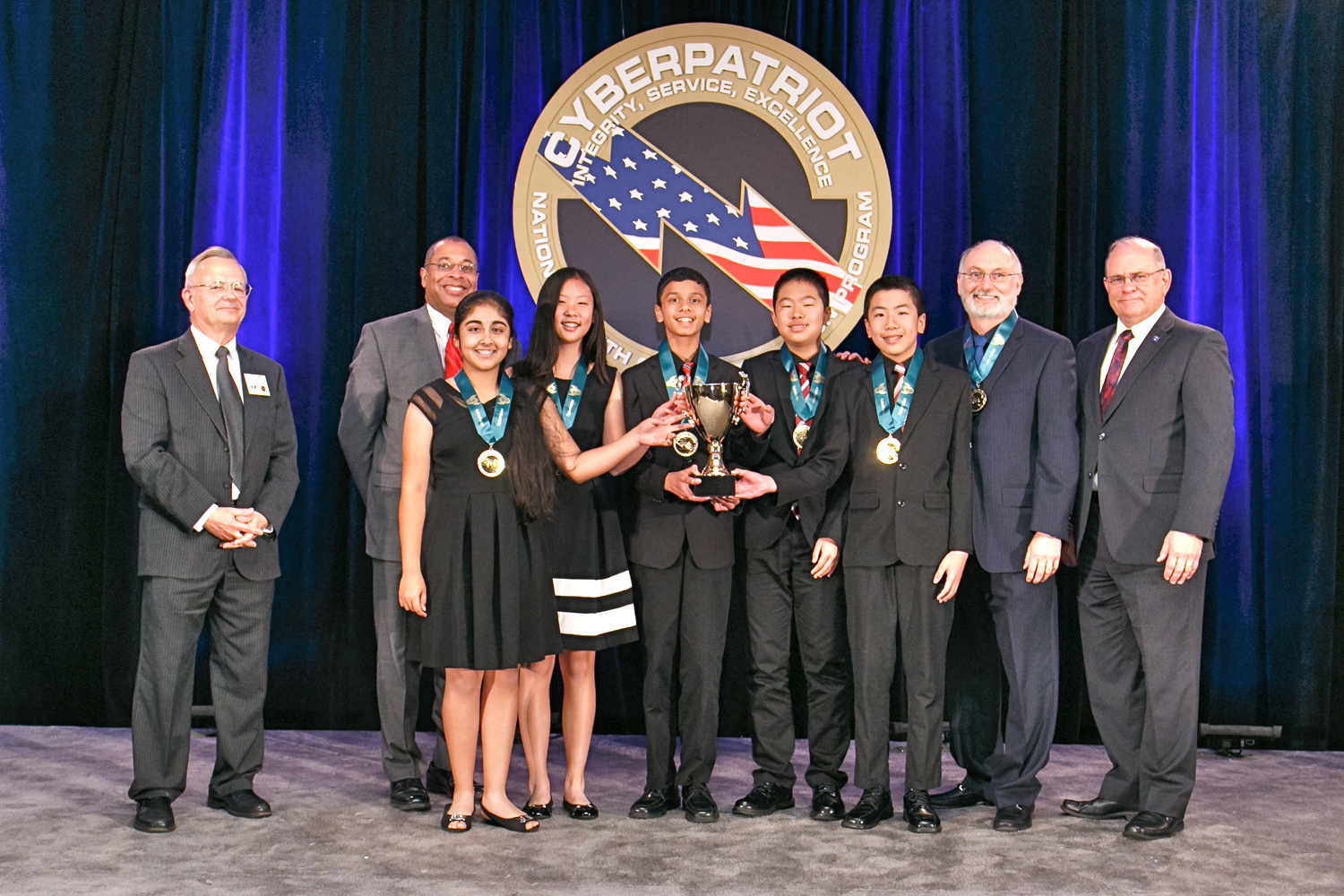
Oak Valley Middle School Wins National
Championship in CyberPatriot Competition
Students and their coaches from Team CyberFalcon Millennium 360, Oak Valley Middle School in San Diego, earned the title of National Champion for the Middle School Division at the CyberPatriot VIII National Finals Competition sponsored by Northrop Grumman Corp.
The award was presented April 13 by Chris Jones, corporate vice president and president of Northrop Grumman Technology Services. Photo by David Keith Photography.
CyberPatriot is the National Youth Cyber Education program created by the Air Force Association and presented by the Northrop Grumman Foundation. It is a one-of-a-kind cyber defense competition designed to inspire students toward futures in science, technology, engineering, and mathematics (STEM) fields.
Northrop Grumman Corp. awarded $50,500 in scholarships to school students on the winning teams.
UC San Diego Scientists Receive $9.5M
Grant to Combat Antibiotic Resistance
Researchers at the UC San Diego School of Medicine have received a five-year, $9.5-million award from the National Institute of Allergy and Infectious Diseases at the National Institutes of Health to combat antibiotic resistance.
The program will be led by Bernhard Palsson, professor of bioengineering and pediatrics, and Victor Nizet, professor of pediatrics and pharmacy.
Bacteria that no longer reliably respond to antibiotic therapy, so-called “superbugs,” pose one of the greatest threats in modern medicine. Superbugs, such as methicillin-resistant Staphylococcus aureus Clostridium difficile and carbapenem-resistant Enterobacteriaceae, often strike hospitalized patients, the elderly or those with weakened immune systems or chronic medical conditions. The U.S. Centers for Disease Control and Prevention estimate that at least 2 million Americans become infected with antibiotic-resistant bacteria and at least 23,000 people die each year as a direct result of these infections.
“I worry that approaches currently used in the clinic to evaluate antibiotic activity are antiquated and simplistic, and address the drug’s action only on bacteria growing in artificial laboratory media without attention to the human immune system,” Nizet said. “Our research has shown that certain antibiotics can synergize with the natural defenses of our immune system to clear infections in a way that wouldn’t have been predicted by current testing paradigms.”
Palsson is a leader in the emerging field of systems biology, which explores the complexity of living systems — from the genome to the entire organism — using experimental and computational methods. Concerned by the exploding problem of drug-resistant bacterial pathogens, Palsson reached out to Nizet, a physician-scientist, to explore whether systems-level approaches could be coupled with experimental models of antibiotic drugs, living bacterial pathogens, human immune cells and animal models of infection to benefit patients with antibiotic-resistant infections.
“Dr. Nizet’s work demonstrates how unexpected environmental factors influence the efficacy of antibiotics. Thus, improving treatment outcomes in serious or antibiotic-resistant bacterial infection will require systems-level analyses at the molecular level,” said Palsson. “We could paraphrase and honor geneticist and evolutionary biologist Theodosius Dobzhansky’s famous quote by saying: ‘Nothing in biology makes sense, except in the light of systems thinking.’”
The new research program will be headquartered in the UC San Diego School of Medicine, Department of Pediatrics, Division of Host-Microbe Systems and Therapeutics.
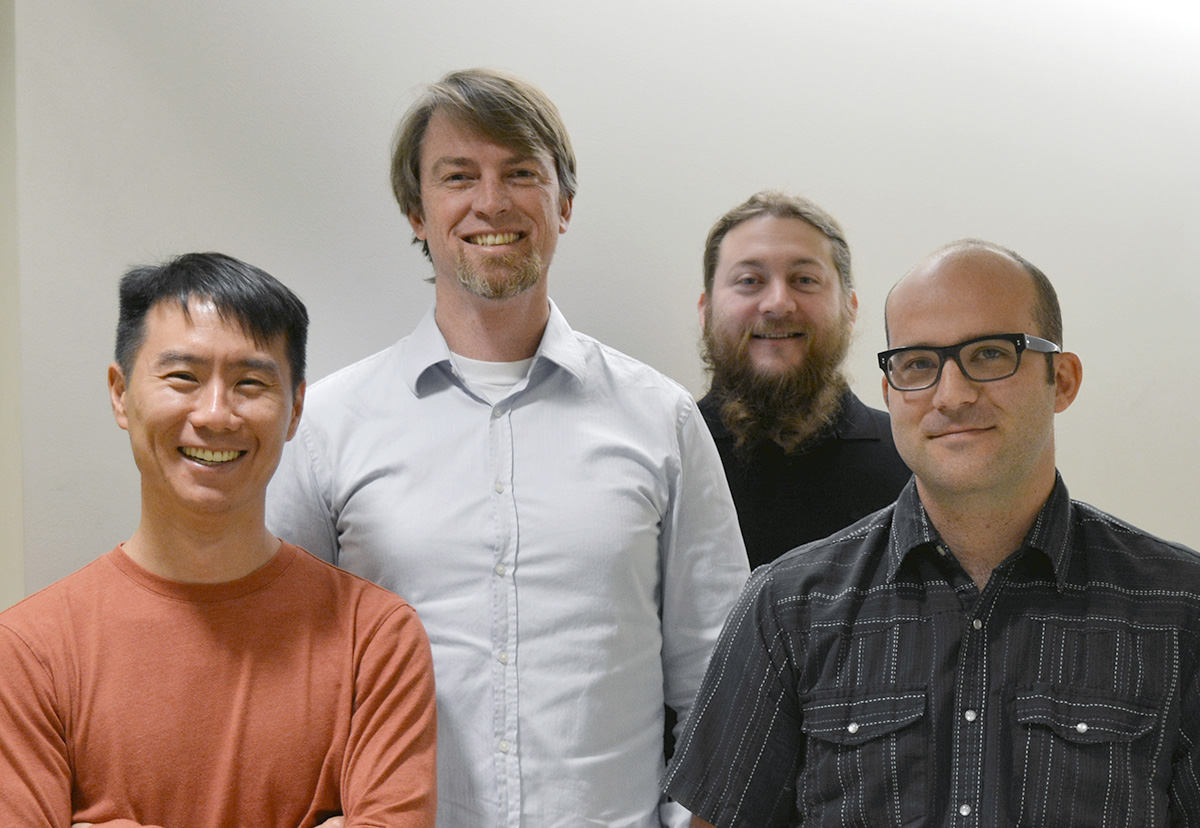
With Wikidata, Scientists Can Now Store
Data that is Easily Accessed by Others
Scientists at The Scripps Research Institute are storing biomedical data into Wikidata, a public, editable database where researchers can easily link genes, proteins and other data.
The project is intended to solve the problem where scientists attempt to gather data scattered across small databases and hard-to-search PDF files.
“It’s not that the data doesn’t exist,” said Andrew Su, associate professor at the institute. “The data just isn’t stored in a way that scientists can easily access.”
“Open data is vital for progress and research,” added Assistant Professor of Molecular and Experimental Medicine Ben Good. “We need to break down those barriers.”
Su, Good and their colleagues at TSRI have integrated biomedical data into Wikidata. Built on the same principles as Wikipedia, Wikidata enables anyone to add new information to an open community database.
Technological breakthroughs in the last 10 years have led to rapid increases in the volume and rate of biomedical research, which in turn has led to a rapid growth in biomedical knowledge. However, this knowledge is currently fragmented across countless resources — from online databases to supplementary data files to individual facts in individual papers.
“As a research community, we spend a lot of time searching for good resources and trying to link them together,” said TSRI Research Associate Tim Putman, who was first author of one of the studies. “It’s cringeworthy.”
Even when databases are open to the public, current knowledge isn’t always organized in a uniform way, Putman explained.
Rather than leave each research group to tackle data integration individually, Wikidata offers a new model for organizing all this information.
While other Wikidata editors have added information on millions of items as diverse as works of art to U.S. cities, the TSRI team has focused on adding information on biomedical concepts.
TSRI Research Associate Sebastian Burgstaller-Muehlbacher, first author on one study, added data on all human and mouse genes, all human diseases and all drugs approved by the U.S. Food and Drug Administration.
As a proof of concept, Putman led the development of a genome browser based on Wikidata. Rather than having to develop one browser for every sequenced genome, this genome browser allows users to browse any genome that has been loaded into Wikidata.
“You can zoom in on a gene, click on it and the sequence will pop up,” said Good. The genome browser will then link back to the original Wikidata entry.
In the end, the researchers plan to have a comprehensive, uniform database that is easy to search and open to anyone who wants to add data and link related concepts.
“We think this data should all be open,” said Su. “This just makes intuitive sense.”
AMN Healthcare Exec Named
Communicator of the Year
By Rick Griffin

San Diego’s International Association of Business Communicators has selected AMN Healthcare’s Anna Davison for its 2016 Communicator of the Year award.
Davison, director of corporate communications at AMN, will be honored at a ceremony starting at 6 p.m., Wednesday at Hash House a Go Go, 3628 Fifth Ave. in Hillcrest.
At AMN, Davison oversees internal and external strategic communications initiatives. Prior to joining AMN, she served as director of corporate communications at FTD Companies, previously Provide Commerce, and in a variety of roles at Science Applications International Corp., including director of marketing and communications, deputy director of electronic communications and operations manager.
“I feel so honored to be recognized by my colleagues in this organization,” said Davison. “IABC is not only a great resource for networking and professional development, it is a group of people who are all truly committed to the shared passion of improving organizational effectiveness through strategic communication.”
Recipients of the IABC award are nominated by their peers. Judging is based on leadership, management and communication skills, strategy development and communicating to diverse audiences.
Cost to attend the award ceremony is $20 for members, $30 for nonmembers.


